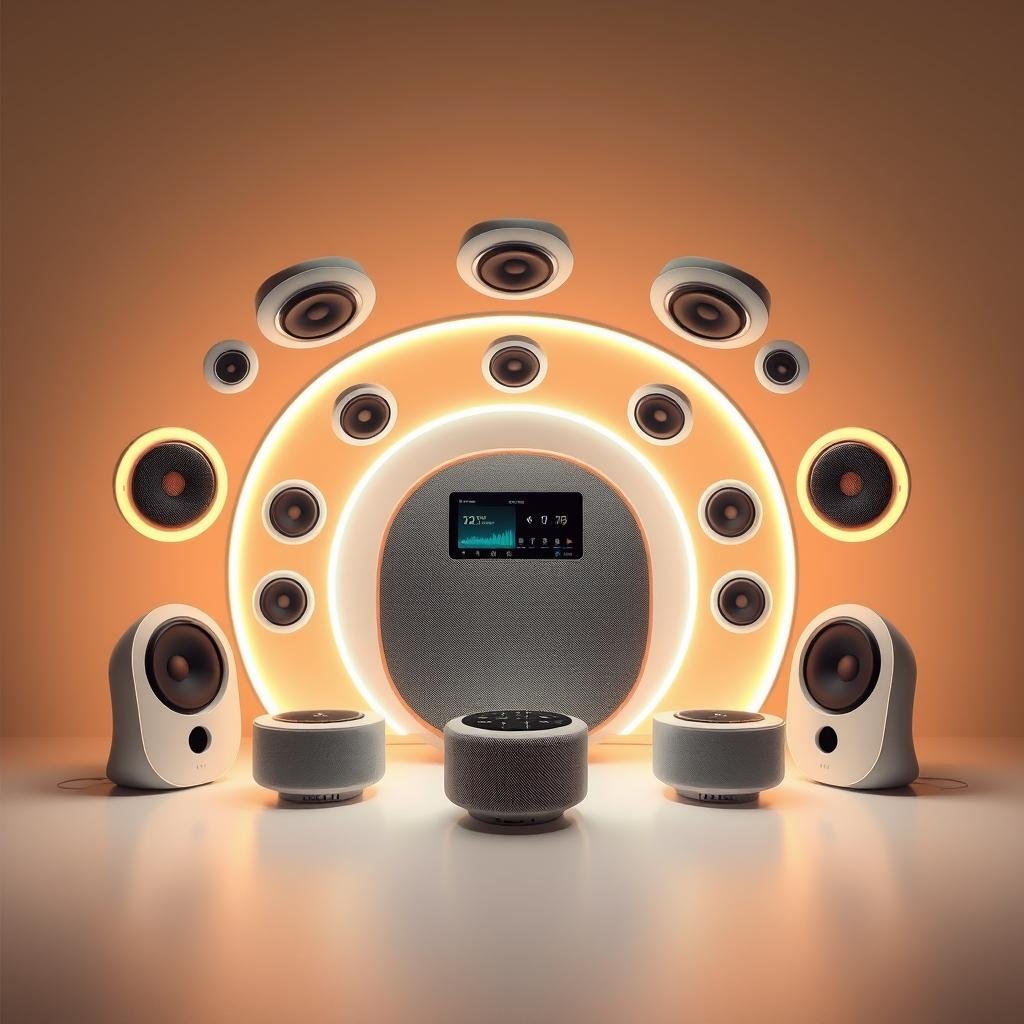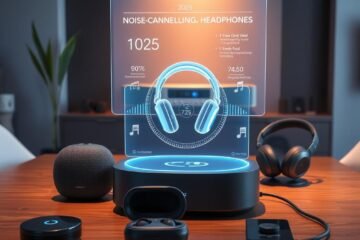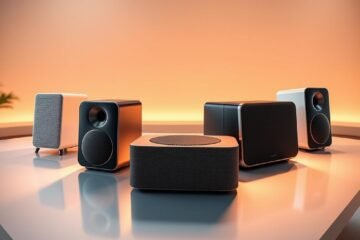In 2025, audio technology is changing fast, thanks to artificial intelligence. You might already know how great smart speaker devices are for your daily life.
Did you know the market for artificial intelligence audio devices is growing fast? It’s changing how we listen to and interact with audio. As we enter 2025, it’s clear this year will be big for smart listening. New innovations promise to make your audio experience even better.
Key Takeaways
- Discover the top AI-Powered Smart Audio Gadgets of 2025.
- Learn what makes an audio gadget “AI-powered.”
- Understand why 2025 is a significant year for smart listening.
- Explore the latest advancements in AI technology.
- Find out how these gadgets can enhance your daily life.
The Evolution of Smart Listening in 2025
The evolution of smart listening has hit a major milestone in 2025, thanks to AI and connected home tech. Now, audio tech is changing how we live, making sound more personal and interactive than ever.
The Rise of Intelligent Audio Experiences
Intelligent audio experiences are becoming the standard, thanks to voice assistant technology and connected home technology. These advancements are changing how we listen to audio and interact with smart devices. AI lets audio gadgets learn your preferences and adjust to your listening habits, giving you a more tailored experience.
The growth of intelligent audio is also fueled by the need for smart home devices that work together seamlessly. You’re seeing a blend of technologies that make using smart devices easier and more intuitive. For example, smart speakers can now adjust their sound based on your environment, ensuring the best quality sound wherever you are.
Why 2025 Is a Turning Point for Audio Technology
2025 is a key year for audio tech because it’s when AI-powered audio gadgets become common. These devices can handle complex tasks like real-time translation, noise cancellation, and sound adjustments. This means you can enjoy advanced audio features that were once only available in high-end products.
Also, AI is improving professional audio equipment, not just consumer gadgets. It’s adding features that boost recording, editing, and playback. This mix of consumer and professional audio tech is raising the bar for the whole industry.
What Makes Audio Gadgets “AI-Powered”?
The term ‘AI-powered’ is often used in the context of audio gadgets, but what does it really mean? As we explore the world of intelligent audio, it’s key to understand the technologies behind these devices. They offer more than just sound reproduction.
Core Technologies Behind Intelligent Audio
AI-powered audio gadgets use several core technologies. Machine learning algorithms let devices learn and adapt to user preferences over time. For example, some AI-powered headphones adjust their sound based on what you’ve listened to before.
Natural language processing (NLP) is another key technology. It lets devices understand and respond to voice commands. This is vital for voice-controlled gadgets, making it easy to interact with them without using your hands.

A leading expert in AI technology says, “The integration of AI into audio gadgets has opened up new possibilities for personalized listening experiences.” This personalization is a key feature of truly AI-driven sound systems.
The Difference Between Smart and Truly AI-Driven Sound
Many modern audio gadgets are called “smart,” but not all are truly AI-driven. Smart devices might offer some connectivity or basic voice control. But they lack the advanced learning and personalization of AI-powered devices.
Truly AI-driven sound systems, though, use complex algorithms to learn and adapt to user behavior. They can offer adaptive sound profiles, real-time translation, and more. These features enhance the listening experience.
In conclusion, what makes an audio gadget “AI-powered” is its use of artificial intelligence technologies like machine learning and NLP. These technologies provide a more personalized and adaptive listening experience. As AI technology evolves, we’ll see even more innovative uses in audio gadgets.
Top AI-Powered Smart Audio Gadgets of 2025
This year, the best AI-powered smart audio gadgets are leading the way in sound quality and user experience. They are getting smarter, giving us a more personal and immersive way to listen.
How to Set Up and Optimize Premium AI Headphones
In 2025, setting up your premium AI headphones is key for top-notch sound. AI audio tech has advanced fast. Knowing how to set up your device boosts your listening fun.
Sony WH-1000XM5: Setting Up the Best Overall Smart Headphones
The Sony WH-1000XM5 is the top smart headphones. It has adaptive AI-based noise cancellation and Speak-to-Chat. Here’s how to get started:
- Download and install the Sony Headphones Connect app.
- Enable adaptive noise cancellation to automatically adjust ambient sound.
- Customize your sound settings using the app’s equalizer.
- Activate Speak-to-Chat to pause your music and start a conversation.
Sony says the WH-1000XM5’s AI can automatically adjust noise cancellation based on your surroundings. This ensures the best sound for you.

Bose QuietComfort Ultra: Configuring for Travel Excellence
The Bose QuietComfort Ultra is perfect for travel. It has top-notch noise cancellation and voice controls. Here’s how to make the most of it:
- Download the Bose Music app to access advanced features.
- Enable noise cancellation and adjust levels according to your environment.
- Use voice commands to control your music and calls.
- Customize your listening experience with the app’s personalized settings.
Here’s a comparison of the Sony WH-1000XM5 and Bose QuietComfort Ultra:
| Feature | Sony WH-1000XM5 | Bose QuietComfort Ultra |
| Noise Cancellation | Adaptive AI-based | Advanced Noise Cancellation |
| Voice Control | Speak-to-Chat | Voice Commands |
| Battery Life | Up to 30 hours | Up to 24 hours |
“The future of audio is not just about listening; it’s about experiencing. With AI-powered headphones, you’re not just hearing music; you’re living it.”
By following these tips, you can get the most out of your premium AI headphones. Enjoy amazing sound in 2025.
How to Maximize Specialized AI Audio for Work and Fitness
To get the most out of AI audio, focus on its features for work and fitness. Learn how to use these devices’ advanced features. This will greatly improve your audio experience.

Jabra Evolve2 75: Optimizing for Professional Environments
The Jabra Evolve2 75 is made for professionals. It has AI-enhanced microphones for clear calls on MS Teams and Zoom. To use it best for work, do the following:
- Turn on noise isolation to block out distractions.
- Adjust settings in the Jabra app for better call quality.
- Customize sound with the built-in equalizer.
Experts say AI in devices like the Jabra Evolve2 75 changes professional communication. It’s great at adapting to different places.
Shokz OpenRun Pro: Configuring for Active Lifestyles
The Shokz OpenRun Pro is perfect for active people. To use it well, follow these steps:
- Change sound settings for better workout sound.
- Use its open-ear design to stay aware while exercising.
- Enjoy long battery life for non-stop audio during workouts.
“The Shokz OpenRun Pro is a big step forward in AI in audio tech, ” says experts. It’s great for runners and cyclists because of its sound quality and awareness.
By using AI audio devices like the Jabra Evolve2 75 and Shokz OpenRun Pro, you stay ahead in smart audio innovations. You’ll get a more personalized audio experience.
How to Install and Configure Smart Speakers and Budget Options
In 2025, the smart speaker market is growing fast. New devices promise better sound experiences. There are many options, from high-end to budget-friendly, to fit everyone’s needs and budget.
Setting up smart speakers can vary by brand and model. We’ll show you how to set up two popular ones: the Amazon Echo Studio (2nd Gen) and the Soundcore Space A40 by Anker. Both are top picks for 2025, with cool features like spatial audio and room-adaptive tuning.
Amazon Echo Studio (2nd Gen): Home Audio Setup Guide
The Amazon Echo Studio (2nd Gen) is known for its great sound. It has spatial audio and room-adaptive tuning. Here’s how to get started:
- Plug in the Echo Studio and turn it on.
- Download and open the Amazon Alexa app on your smartphone or tablet.
- Follow the in-app instructions to connect your Echo Studio to your Wi-Fi network.
- Once connected, you can start exploring the device’s features, including its ability to adapt to your room’s acoustics.
Amazon says, “The Echo Studio is designed to deliver an immersive audio experience, making it perfect for music lovers and those who enjoy cinematic experiences at home.”
“With its advanced audio capabilities and seamless integration with Alexa, the Echo Studio is a top choice for home audio enthusiasts.”

Soundcore Space A40 by Anker: Budget-Friendly Configuration
If you’re on a tight budget, the Soundcore Space A40 by Anker is a great choice. It has important features without the high price. Here’s how to set it up:
- Charge the device and turn it on.
- Download the Soundcore app to access additional features and customization options.
- Pair the Space A40 with your device via Bluetooth.
- Use the app to adjust EQ settings and enable features like noise cancellation.
| Feature | Amazon Echo Studio (2nd Gen) | Soundcore Space A40 by Anker |
| Spatial Audio | Yes | No |
| Room-Adaptive Tuning | Yes | No |
| Smart Home Integration | Yes, with Alexa | Limited |
| Price | Premium | Budget-Friendly |
In conclusion, the Amazon Echo Studio (2nd Gen) and Soundcore Space A40 by Anker are leading the way in 2025. They offer unique features for different needs. The smart speaker market is set to get even more exciting, with new devices coming out all the time.
These AI-powered smart audio gadgets are changing how we hear sound. They offer better sound quality, more functionality, and convenience.
Revolutionary Features That Transform Your Listening Experience
AI technology has changed how we listen to music and talk. Smart audio devices now offer features that make sound better and more personal. They give you a unique and interactive listening experience.
Adaptive Sound Profiles and Personalization
Modern AI audio gadgets create adaptive sound profiles just for you. They adjust to your listening habits over time. This means the sound is always perfect for your ears.
Some devices even change the sound based on your ear shape. This makes listening more immersive.
- Personalized sound settings based on your listening habits
- Automatic adjustments for different environments
- Customizable EQ settings through companion apps
Real-time Translation and Communication Enhancements
AI gadgets now break language barriers with real-time translation. This is great for travelers or anyone who talks to people in different languages. They can translate conversations as they happen, making communication smoother.
Real-time translation isn’t the only thing they offer. They also have features like noise-cancelling and voice amplification. These are key in loud places.

Contextual Awareness and Environmental Adaptation
Contextual awareness lets your device understand its surroundings and adjust. Whether you’re in a quiet library or a busy street, it changes the sound settings for the best listening experience.
- Automatic pause or volume adjustment when you receive a call or notification
- Environmental sound adaptation for optimal listening
- Seamless integration with other smart devices in your home or office
These features make listening more intuitive and fun. They show how AI-powered gadgets can change how we experience sound.
How Smart Assistants Enhance Your Audio Control
Smart assistants have changed how we use our audio devices. Now, you can control your music and podcasts with just your voice. This makes them key to modern audio gadgets.

Comparing Voice Assistant Technologies
Many voice assistant technologies are out there, each with its own benefits and drawbacks. Amazon’s Alexa, Google Assistant, and Apple’s Siri are among the most well-known. When we compare them, we look at things like how well they work with other devices, how accurate they are, and what features they offer.
Alexa is great because it works well with lots of smart devices. Google Assistant is good at understanding what you mean, even if you don’t say it exactly right. Siri works best if you’re using Apple products, because it’s made to work with them.
Natural Language Processing Advancements
Natural Language Processing (NLP) has gotten a lot better in recent years. This means voice assistants can now understand and answer your questions more accurately. They can even understand the context of what you’re saying, making talking to them feel more natural.
“The future of voice assistants lies in their ability to understand the nuances of human language, and NLP is key to achieving this goal.”
– Expert in AI and Voice Technology
As NLP keeps getting better, voice assistants will get even smarter. They’ll be able to handle more complex commands and interactions. This will make controlling your audio even easier and more enjoyable.
How to Select the Perfect AI-Powered Smart Audio Gadget
Choosing the right AI-powered audio device has become easier with new tech. It’s important to know what you need and how different features can improve your listening. This is key when looking at the many options in 2025.
Step 1: Define Your Primary Use Case
First, figure out how you plan to use the device. Do you want it for home entertainment or something portable for work? Your needs will help you find the best gadget.
If you’re into fitness, look for something waterproof. For professional use, noise cancellation and clear sound are more important.
Step 2: Identify Essential AI Features
AI gadgets offer many features to enhance your listening. Think about adaptive sound, real-time translation, and knowing your surroundings. Pick the features that matter most to you.
For example, if you’re often in loud places, a device with great noise cancellation is a must. Travelers might want one that translates languages in real-time.
Step 3: Assess Ecosystem Compatibility
How well the gadget works with your current setup is key. If you’re all about Apple, choose a gadget that works well with your iPhone. Android users should find something that integrates well with their devices.
Good ecosystem compatibility means easy pairing, voice control, and more. It makes using your device smoother.
Step 4: Evaluate Battery Life and Connectivity
Think about how long the device lasts and its connectivity options. You might need one that lasts days or one that charges quickly.
Also, consider what connectivity you need. Look for Bluetooth, Wi-Fi, or NFC. Some gadgets even pair with multiple devices at once.
By thinking about these points, you can pick the right AI gadget. It will meet your needs and make listening better.
Advantages and Limitations of AI-Powered Smart Audio Gadgets
Exploring AI-powered smart audio gadgets, we find both pros and cons. These devices change how we hear sound, making our lives better. Yet, they also have downsides to think about.
Benefits of Next-Generation Audio Experiences
AI gadgets offer many good things. Here are some key benefits:
- Personalized Listening Experiences: AI learns what you like and adjusts the sound for you.
- Enhanced Sound Quality: Better audio processing means sound that’s more real and fun.
- Seamless Integration with Smart Home Devices: They work well with other smart home gadgets, making everything connected.
- Real-time Translation and Communication: Some gadgets translate languages live, helping us connect better.
Potential Drawbacks to Consider
But, there are also some downsides to AI gadgets:
- Privacy Concerns: Using AI for personalization can worry some about their data being used.
- Dependence on Technology: Relying too much on these gadgets might make us less connected to the world.
- Cost: These gadgets are pricier than regular ones, making them hard for some to buy.
- Complexity: Their advanced features can be hard to use, confusing some people.
In summary, AI gadgets improve our listening experiences a lot. But, we should also think about the downsides before buying them.
The Future of Personal Audio: AI Innovations on the Horizon
Personal audio is on the verge of a big change, thanks to AI. This change will make our listening experiences much better. AI and audio technology are coming together to create a new world where sound is more than just heard.
Emerging Technologies to Watch
Several new technologies are going to change personal audio. Artificial Intelligence (AI) and Machine Learning (ML) are leading the way. They help devices learn and adjust to what we like.
- Advanced noise cancellation techniques
- Personalized sound profiles through AI-driven analytics
- Integration with augmented reality (AR) for immersive experiences
These technologies are not just making audio better. They’re also opening up new ways for us to experience sound.
Predictions for Audio Technology Through 2030
By 2030, the personal audio world will see big changes. Predictions suggest that audio devices will become a big part of our daily lives. They will work well with other smart devices in our homes and on our bodies.
Some key predictions include:
- Increased adoption of voice-controlled interfaces
- Further personalization through advanced AI algorithms
- Enhanced connected home devices for a more integrated audio experience
As these technologies get better, we’ll get a more personalized, immersive, and connected audio experience. This will keep changing how we enjoy and interact with sound.
Conclusion: Embracing the Smart Audio Revolution in 2025
As we enter 2025, audio technology is changing a lot. AI-powered gadgets are making sound more personal and smart. They fit into our lives in new ways.
The smart audio world is growing thanks to AI, smart homes, and new audio tech. Devices like SoundMind Pro X1 and HomeSound Hub5 offer great sound experiences. They’re made just for you.
When looking at AI smart audio gadgets, think about how you’ll use them. Look at the AI features and if they work with your other tech. This new world of sound can make your life better in many ways.
The future of audio is looking bright. New tech is coming that will change how we listen. Stay curious and see how these gadgets can change your life.


![Best Compact Soundbars 2025 for Small Rooms [Budget Picks]](https://fataimm.com/wp-content/uploads/2025/06/Best-Compact-Soundbars-2025-360x240.jpeg)



![Best Audiophile Over-Ear Headphones in 2025 [Top 5]](https://fataimm.com/wp-content/uploads/2025/06/audiophile-over-ear-headphones-in-2025-360x240.jpeg)